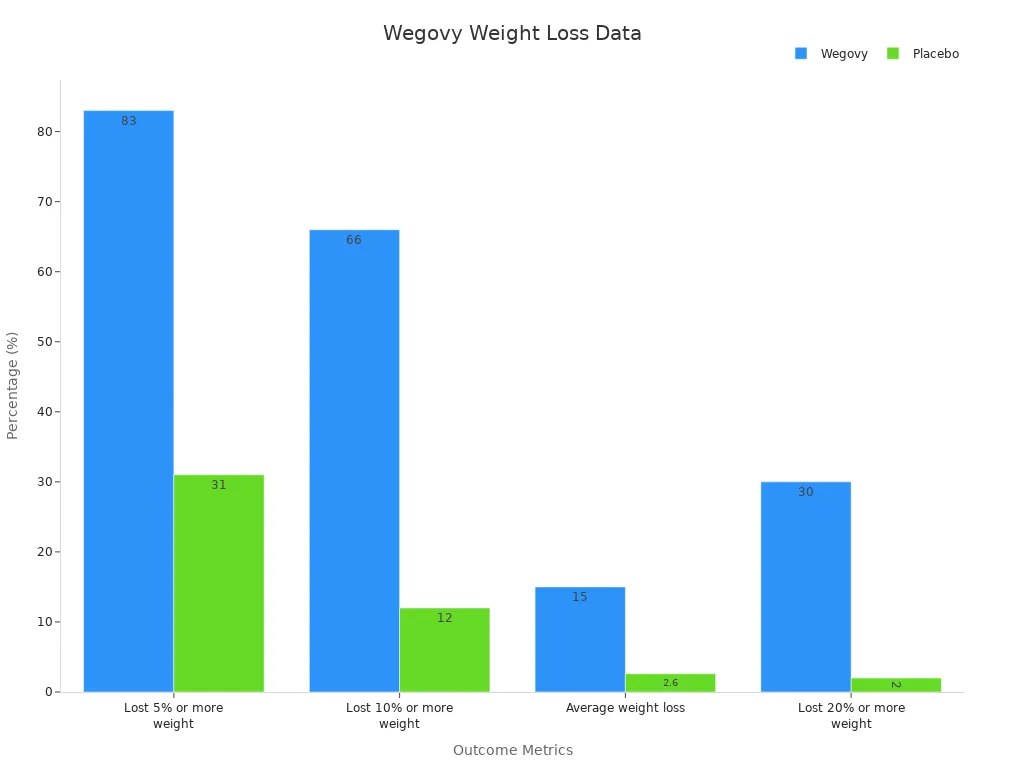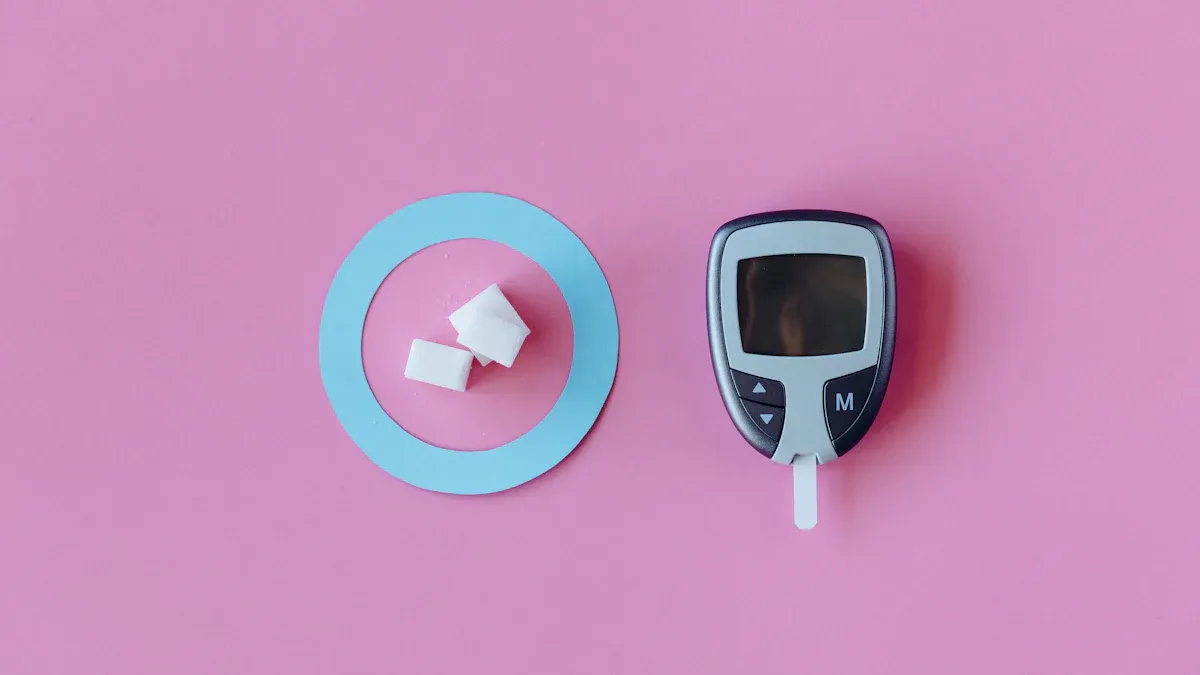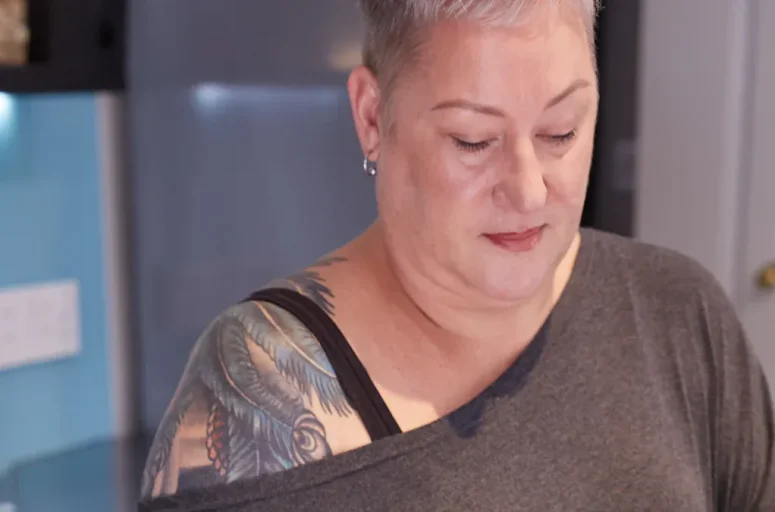
Zepbound is the leading GLP-1 weight loss option in 2025. It demonstrates remarkable results in assisting individuals with weight loss. Research indicates that adults taking 15 mg weekly experienced a weight loss of up to 23%, which averages around 52 pounds. A 10 mg weekly dose resulted in a 21% weight loss, while a 5 mg weekly dose led to a 16% weight loss. These outcomes surpass those of Ozempic and Wegovy.
Choosing the right GLP-1 weight loss medication involves more than just its effectiveness. Safety, potential side effects, and personal factors such as age and health history are also important considerations. For instance, recent studies reveal that mental health risks can vary from person to person. This highlights the need for treatments to be tailored to individual needs. Always consult with a doctor to determine the best GLP-1 weight loss option for you.
Key Takeaways
Zepbound is the best GLP-1 drug for weight loss in 2025. It helps people lose up to 21% of their body weight.
Ozempic and Wegovy also help with weight loss but less than Zepbound. People lose about 10-15% with Ozempic and 15% with Wegovy.
It is important to talk to a doctor to pick the right GLP-1 drug. This depends on your health and possible side effects.
GLP-1 drugs copy a hormone that controls hunger. They help you feel full faster and eat less food.
These three drugs are taken once a week. This is easier than older drugs that were taken daily.
Some side effects are nausea and diarrhea. Zepbound causes fewer stomach problems than Ozempic and Wegovy.
Insurance for GLP-1 drugs is not always covered. Only about 25% of U.S. employers pay for them, so cost matters.
Handling side effects well can make GLP-1 drugs work better. Starting with a small dose and slowly increasing it can help.
How GLP-1 Medications Help with Weight Loss
How GLP-1 Works for Weight Loss
GLP-1 medications have changed how we manage weight. They copy the actions of a hormone called glucagon-like peptide-1 (GLP-1). This hormone helps control hunger and blood sugar levels. These drugs activate GLP-1 receptors in the brain. This makes you feel full faster and eat less food.
Studies show GLP-1 receptor agonists (GLP-1RAs) work well for weight loss. Research, including trials, proves they are safe and effective. Medications like liraglutide, semaglutide, and tirzepatide help adults and teens lose weight. These results make GLP-1 drugs key in treating obesity today.
How Ozempic, Wegovy, and Zepbound Work
Knowing how GLP-1 drugs work shows why they are effective. Ozempic and Wegovy both use semaglutide, a GLP-1 receptor agonist. This boosts insulin release and lowers hunger by acting on GLP-1 receptors in the brain and gut. Ozempic is mainly for Type 2 diabetes and heart health. Wegovy focuses on weight loss and preventing heart problems in obese adults.
Zepbound uses tirzepatide, which activates GLP-1 and GIP receptors. This dual action helps reduce hunger and improve insulin use. These differences explain why Zepbound often leads to more weight loss than Ozempic or Wegovy.
How It Works | What It Does |
|---|---|
GLP-1 makes you feel full, so you eat less. | |
Slower Digestion | It slows stomach emptying, keeping you full longer. |
Insulin Boost | Helps release more insulin, controlling blood sugar better. |
Brain Signals | Activates brain areas to reduce hunger and cravings. |
Why GLP-1 Medications Are Big in 2025
In 2025, GLP-1 drugs are changing weight loss treatments. These FDA-approved drugs are now a top choice for managing weight. Their use is expected to grow by 73.1%, showing their popularity. About 24% of people are thinking about using them for weight loss.
But their impact goes beyond personal results. GLP-1 drugs now make up 6.7% of total drug spending. Even with cost concerns, they are vital for fighting obesity and related health problems. Employers and healthcare providers are working to keep these drugs available for those who need them.
Effectiveness of Ozempic vs Wegovy vs Zepbound
Clinical Outcomes for Ozempic
Ozempic uses semaglutide and helps people lose weight effectively. Studies show users lose 15% to 20% of their body weight. This is much better than older weight loss medicines. Some people even lose up to 30% of their weight. This makes Ozempic a strong option for treating obesity.
About one in three Ozempic users lose 10% of their weight. This shows how well it works for weight-related problems. The highest dose of Ozempic is 2 mg. This is slightly less than Wegovy’s top dose of 2.4 mg. Even so, Ozempic is still a great choice for steady weight loss results.
Clinical Outcomes for Wegovy
Wegovy is another semaglutide medicine made for weight loss in adults. It has shown great results in studies. In one study with over 17,000 people, Wegovy users lost about 15% of their weight. This is much higher than the 2.6% weight loss in the placebo group. Also, 66% of Wegovy users lost 10% or more of their weight. Around 30% of users lost 20% or more.
Metric | Wegovy (%) | Placebo (%) |
|---|---|---|
Lost 5% or more weight | 83 | 31 |
Lost 10% or more weight | 66 | 12 |
Average weight loss | ~15 | 2.6 |
Lost 20% or more weight | ~30 | ~2 |
Wegovy does more than help with weight loss. It also reduces waist size and improves body proportions. These benefits make Wegovy a trusted choice for managing obesity.

Clinical Outcomes for Zepbound
Zepbound, which uses tirzepatide, is the best GLP-1 drug for weight loss in 2025. In the SURMOUNT-5 study, Zepbound users lost 20.2% of their weight, or about 50.3 pounds. This is better than Wegovy’s 13.7% weight loss, or 33.1 pounds, over 72 weeks. Zepbound works on both GLP-1 and GIP receptors. This helps reduce hunger and improve insulin use, leading to better weight loss.
Key findings from the study include:
Zepbound users lost 47% more weight than Wegovy users.
The study had 751 adults and was the first to compare these two drugs directly.
These results show Zepbound’s ability to help with major weight loss. It is a top choice for fighting obesity in 2025. Zepbound also helps with insulin resistance, making it even more effective.
Note: These medications work well, but results can differ for everyone. Always talk to a doctor to find the best option for you.
Which Is Better for Weight Loss?
Choosing the best GLP-1 for weight loss depends on many things. Each option—Ozempic, Wegovy, and Zepbound—has its own benefits. Let’s look at the key points to help you decide.
Effectiveness
In 2025, Zepbound is the top GLP-1 for weight loss. Studies show adults using tirzepatide, its main ingredient, lose about 21% of their weight. Some people even lose over 50 pounds. This is better than results from Ozempic and Wegovy, which use semaglutide. Wegovy users lose about 15% of their weight, while Ozempic users lose 10% to 15%.
Zepbound works on both GLP-1 and GIP receptors. This helps reduce hunger and improve insulin use. Ozempic and Wegovy only target GLP-1 receptors. This difference makes Zepbound more effective for weight loss.
Dosing Convenience
How easy a medication is to use also matters. All three—Ozempic, Wegovy, and Zepbound—are taken weekly. This is easier than older treatments like liraglutide, which needs daily injections. Weekly doses make it simpler to follow your treatment plan.
Side Effects
Side effects are important to think about. GLP-1 drugs like Ozempic, Wegovy, and Zepbound can cause nausea, vomiting, or diarrhea. But Zepbound is often easier to handle because of its dual-action design. Ozempic and Wegovy may cause more stomach problems for some people.
Everyone reacts differently to these medications. What works for one person might not work for another. Talk to your doctor about side effects and how to manage them.
Final Thoughts
For the best weight loss results, Zepbound is a great choice. It offers big weight loss, weekly dosing, and fewer side effects. Still, Wegovy and Ozempic are good options, especially for those who do well with semaglutide. Your choice should depend on your health, history, and how your body responds.
Note: This is based on research and not medical advice. Always talk to your doctor to find the best treatment for you.
Safety and Side Effects of GLP-1 Medications
Common Side Effects of Ozempic, Wegovy, and Zepbound
Using GLP-1 medications like Ozempic, Wegovy, and Zepbound may cause side effects. These are usually mild but can differ by medication. Stomach problems are the most common, like nausea, vomiting, or diarrhea. These affect 40% to 70% of users. For example, 44% of Wegovy users feel nauseous, while 28% of Zepbound users do. Diarrhea happens in 30% of Wegovy users and 23% of Zepbound users. Vomiting and constipation are less frequent but still occur.
Side Effect | Wegovy (%) | Zepbound (%) |
|---|---|---|
Nausea | 44 | up to 28 |
Diarrhea | 30 | up to 23 |
Vomiting | 24 | up to 13 |
Constipation | 24 | up to 11 |
Stomach pain | 20 | up to 10 |
Headache | 14 | N/A |
Feeling tired | 11 | N/A |
Other side effects | Indigestion, dizziness, bloating, burping, hair loss | Injection site reactions, feeling tired, burping, hair loss |
These side effects often get better as your body adjusts. Some people may also notice mood changes or trouble thinking clearly. If symptoms are severe or don’t go away, talk to your doctor right away.
Long-Term Safety of GLP-1 Weight Loss Medications
The long-term safety of GLP-1 medications is still being studied. Research shows they are generally safe when used correctly. A study of 26 trials with over 15,000 people found stomach issues were the most common side effects, affecting 80% to 97% of users. Serious problems were rare, happening in 0% to 10% of cases.
Study Characteristics | Results | Safety Outcomes |
|---|---|---|
26 RCTs, 15,491 participants | Weight loss: Tirzepatide 17.8%, Semaglutide 13.9%, Liraglutide 5.8% | AEs: 80%-97% (gastrointestinal) |
Treatment duration: 16-104 weeks | Retatrutide: 22.1% weight loss | SAEs: 0%-10% |
Participants: 72% female, mean age 34-57 | AEs requiring discontinuation: 0%-26% | Limitations: No head-to-head RCTs, heterogeneity |
Even though these drugs are approved by the FDA, more research is needed. Scientists are looking into their effects on hormones, pregnancy, and specific groups like women. Always talk to your doctor about the risks and benefits to find the safest option for you.
Managing Side Effects in Patients with Obesity
Managing side effects is important for success with GLP-1 medications. Here are some tips to help:
Start with a small dose and slowly increase it.
Take the medication at the same time every week.
Eat smaller meals more often to avoid nausea.
Drink plenty of water to ease diarrhea or constipation.
Combine the medication with healthy habits like eating less and exercising.
If side effects continue, your doctor might suggest other treatments or combinations. Remember, obesity is a long-term condition that needs ongoing care. Stay in touch with your doctor to handle challenges and reach your weight loss goals.
Note: This is for learning purposes only, not medical advice. Always check with a doctor before starting or changing any treatment.
Costs and Accessibility in 2025
Comparing Costs of Ozempic, Wegovy, and Zepbound
The prices of GLP-1 weight loss drugs differ by brand and country. In the U.S., Ozempic costs about $936 monthly. Wegovy is more expensive at $1,349 per month. Zepbound, also called Mounjaro, costs $1,023 monthly. These prices make them some of the priciest weight loss options.
Medication | U.S. Price (1 month) | Price in Japan | Price in Germany | Price in Netherlands |
|---|---|---|---|---|
Ozempic | $936 | $169 | N/A | N/A |
Wegovy | $1,349 | N/A | $328 | $296 |
Zepbound | $1,023 | $319 | N/A | $444 |
Costs depend on where you live and your insurance. For instance, Ozempic costs only $169 in Japan. In Germany, Wegovy is priced at $328. These differences show the need for better global pricing plans to make these drugs affordable for more people.
Insurance Coverage for GLP-1 Weight Loss Medications
Insurance coverage for GLP-1 drugs is uneven. Studies show only 25% of U.S. employers cover these treatments. Access depends on job type, insurance plan, and personal factors. Women and people in high-paying jobs, like finance, are more likely to get these medications. Men or retail workers often have less access.
This uneven coverage creates unfair access to obesity treatments. Many who need Ozempic, Wegovy, or Zepbound cannot afford them. Policymakers and healthcare providers must work to fix these gaps and ensure fair access to these medications.
Note: Talk to your doctor to learn about your insurance and find the best treatment for you.
Cost-Effectiveness of the Best GLP-1 for Weight Loss
The value of GLP-1 drugs depends on their long-term benefits. Zepbound, with tirzepatide, offers the most weight loss but is costly. Studies suggest discounts of 30.5% for tirzepatide and 81.9% for semaglutide are needed to make them affordable.
Group | Year Before Treatment | Year 1 After Treatment | Year 2 After Treatment |
|---|---|---|---|
GLP-1 Treatment | $12,695 | $20,165 (+56.0%) | $18,507 (+45.8%) |
Control Group | $11,406 | $11,882 (+4.1%) | $13,012 (+14.1%) |
These drugs increase healthcare spending, making up nearly half of drug cost rises in 2024. Without insurance, the average monthly cost is about $1,000. This raises concerns about fairness, as many cannot afford these treatments despite their health benefits.
To make these drugs more accessible, healthcare systems need better cost plans. Discounts, subsidies, and more insurance coverage could help people afford GLP-1 medications.
Tip: Ask your doctor about cheaper options and financial aid programs to lower costs.
Dosage and How to Take Them
Dosage Details for Ozempic, Wegovy, and Zepbound
Knowing how to take GLP-1 medications is very important. Each one has its own schedule and dose plan. Here’s a simple comparison of their doses:
Medication | Starting Dose | How It Increases | Maximum Dose |
|---|---|---|---|
Ozempic | 0.25 mg | Go up to 0.5 mg after 4 weeks | 2 mg weekly |
Wegovy | 0.25 mg | Increase to 2.4 mg every 4 weeks | 2.4 mg weekly |
Zepbound | 2.5 mg | Raise to 5 mg after 4 weeks | 15 mg weekly |
Both Ozempic and Wegovy start at the same dose. But Wegovy allows for a higher final dose. Zepbound starts with a bigger dose and can go up to 15 mg weekly. These differences show why it’s important to talk to your doctor about what’s best for you.
Tip: Follow your doctor’s advice to avoid side effects and get the best results.
Weekly Doses and Patient Choices
GLP-1 medications like Ozempic, Wegovy, and Zepbound are taken once a week. This is easier than older treatments that needed daily shots. Studies show people like weekly injections because they are simple and fit into busy lives. Research comparing dulaglutide and semaglutide found that fewer injections and better results, like weight loss, make patients happier.
Weekly shots are easy to fit into your routine. This lets you focus on other parts of weight loss, like eating healthy and exercising. This ease of use is one reason why GLP-1 drugs are so popular for treating obesity.
Note: Some people may prefer different schedules. Talk to your doctor about what works best for you.
Simple Use for Weight Loss in Obesity
GLP-1 medications are made to be easy to use. Weekly shots help people stay on track and not miss doses. Studies show that Wegovy and Zepbound work well because they are simple to take.
GLP-1 drugs like Zepbound help with big weight loss and little effort.
Weekly doses make it easier to stick to your plan.
Side effects like nausea often get better over time, helping people stay on the medication.
These features make GLP-1 drugs a good choice for long-term weight loss. But everyone’s experience is different, so work with your doctor to solve any problems.
Reminder: This is for learning only. Always ask a doctor before starting or changing treatments.
Choosing the Best GLP-1 for Weight Loss
Individual Health Goals and Medical History
Your health goals and medical history are key when picking a GLP-1 medication. These drugs don’t work the same for everyone. If you have diabetes or trouble with insulin, GLP-1 drugs can help control blood sugar and support weight loss. People with a BMI of 30 or higher—or 27 with health issues—may benefit the most.
These medications also offer other health perks. Studies show they can improve brain health and lower risks of seizures or addiction. But their effectiveness depends on your health history. Some people find the benefits worth it, while others face problems like stomach issues or risks to their pancreas or kidneys. Always talk to your doctor about your health and weight goals to find the best fit.
Criteria | What It Means |
|---|---|
Effectiveness | Semaglutide works well for weight loss; CagriSema is noted as the most effective. |
Safety Profiles | Side effects should be considered when choosing a GLP-1 medication. |
Patient Health Conditions | Medications are often chosen based on BMI and specific health needs. |
Tip: Tailor your treatment plan to your health goals. Discuss risks and benefits with your doctor.
Tolerability and Side Effect Management
Handling side effects is important for success with GLP-1 medications. Many users experience stomach problems like nausea, vomiting, or diarrhea. These affect about 59% of patients. Nausea alone impacts up to 32%, and 4% stop treatment due to side effects. Women may face these issues more often than men.
Starting with a small dose and increasing it slowly can help. This lets your body adjust to the medication. Medicines like anti-nausea pills can also ease discomfort. If side effects don’t improve, your doctor might suggest switching to another GLP-1 drug or combining it with one that causes fewer stomach problems.
Evidence Type | Key Details |
|---|---|
Incidence Rate | |
Discontinuation Rate | 4% stopped treatment due to side effects |
Common Side Effect | Nausea affected up to 32% of users |
Correlation Findings | Stomach issues linked to stopping treatment (P < 0.01) |
Gender Influence | Women had more stomach problems than men (P < 0.05) |
Note: Regular check-ups during early treatment can help manage side effects. Always ask your doctor for advice.
Budget and Insurance Considerations
Cost is a big factor in choosing a GLP-1 medication. In 2025, these drugs are pricey. Ozempic costs $936 per month, Wegovy is $1,349, and Zepbound costs $1,023. Insurance can help, but only 25% of U.S. employers cover these medications, leaving many to pay out-of-pocket.
Expanding insurance coverage could make these drugs more affordable. For example, adding heart disease as a reason to use GLP-1 drugs could help 3.6 million Medicare users get coverage. If coverage includes all overweight or obese people, 13.7 million could qualify. But this would cost a lot. Experts estimate adding weight-loss drugs to Medicare Part D could raise federal spending by $35.5 billion from 2026 to 2034.
Tip: Check if your insurance covers GLP-1 medications. If not, ask your doctor about discounts or other options.
Availability of GLP-1 Medications in 2025
In 2025, GLP-1 medications like Ozempic, Wegovy, and Zepbound are easier to find. However, where you live and healthcare systems affect access. Knowing these factors can help you choose the best option.
Global Availability
Many countries now offer GLP-1 medications, but access is not equal. In the U.S., these drugs are widely used for weight loss and diabetes. Urban pharmacies usually have them, but rural areas may face shortages. In Japan and Germany, they are available too, but prices and insurance coverage differ.
Country | Access Level | Key Factors |
|---|---|---|
United States | High | High demand, insurance differences |
Japan | Moderate | Lower cost, rural supply issues |
Germany | High | Strong insurance support |
Developing Nations | Low | Weak healthcare systems |
In developing countries, getting these drugs is harder. Poor healthcare and high costs limit access. Some groups are trying to improve this, but progress is slow.
Supply and Demand in 2025
The demand for GLP-1 drugs has grown a lot. This has caused shortages, especially for newer ones like Zepbound. Companies are making more to meet demand, but delays still happen. Check with your pharmacy early to avoid running out.
Tip: Refill your prescription early to avoid shortages.
Online Pharmacies and Telemedicine
Online pharmacies and telemedicine make it easier to get GLP-1 drugs in 2025. You can talk to a doctor online and get a prescription without leaving home. This helps people in remote areas or with busy schedules.
Be careful when using online services. Make sure the pharmacy is licensed and the medicine is real. Fake drugs can be dangerous.
Final Thoughts
Access to GLP-1 drugs has improved, but challenges remain. Location, demand, and healthcare systems affect availability. Talk to a doctor to find the safest and most effective treatment for you.
Note: This is for learning purposes only. Always consult your doctor before starting or changing medication.
Quick Comparison of Ozempic, Wegovy, and Zepbound

Key Metrics: Effectiveness, Safety, Costs, and Dosage
Ozempic, Wegovy, and Zepbound have similarities and differences. These include how well they work, safety, costs, and dosage. These factors help decide which is best for weight loss.
Effectiveness: Zepbound, with tirzepatide, leads in weight loss results. Adults using Zepbound can lose up to 21% of their body weight. Wegovy users lose about 15%, while Ozempic users lose 10-15%. Switching to bi-weekly doses keeps 75% of the results. Larger doses can help maintain nearly all the weight loss benefits.
Safety: All three are FDA-approved and safe when used correctly. Common side effects include nausea, diarrhea, and vomiting. Zepbound causes fewer stomach problems than Wegovy or Ozempic. Even though they are safe, high costs and shortages make access harder.
Costs: These medications are very expensive. Without insurance, monthly costs are over $1,000. Wegovy costs $1,349, Zepbound is $1,023, and Ozempic is $936. Using alternative dosing plans may lower costs while keeping good results.
Dosage: All three are taken weekly, which is easier than daily injections. Zepbound starts at 2.5 mg and goes up to 15 mg weekly. Wegovy and Ozempic both start at 0.25 mg. Wegovy’s maximum dose is 2.4 mg, higher than Ozempic’s 2 mg.
These points show why Zepbound is often the top choice for weight loss. Still, your decision should match your health, goals, and budget.
Pros and Cons of Each GLP-1 Medication
Each GLP-1 drug has its own good and bad points. Knowing these can help you pick the best one for your needs.
Ozempic
Pros:
Helps with weight loss and Type 2 diabetes.
Costs less than Wegovy and Zepbound.
Improves heart health in people with diabetes.
Cons:
Less weight loss compared to Wegovy and Zepbound.
More likely to cause nausea and diarrhea.
Wegovy
Pros:
Made for weight loss, with results up to 15%.
Shrinks waist size and improves body shape.
Higher dose (2.4 mg) boosts effectiveness.
Cons:
Most expensive, costing $1,349 per month.
Causes nausea, diarrhea, and vomiting in many users.
Zepbound
Pros:
Best weight loss results, up to 21% of body weight.
Dual-action design reduces hunger and improves insulin use.
Fewer stomach issues than Wegovy or Ozempic.
Cons:
Still costly at $1,023 per month.
Hard to find due to high demand and low supply.
Tip: Talk to your doctor before starting any GLP-1 medication. They can help you choose based on your health and goals.
Zepbound is the top GLP-1 for weight loss in 2025. It helps users lose up to 21% of their weight. But, your health needs should guide your choice. Medications like Ozempic, Wegovy, and Zepbound may work differently for each person. Always talk to a doctor to find the right treatment for your health and goals.
Learn about each option before deciding. Talk with your doctor about side effects, costs, and benefits. This will help you pick the best GLP-1 for your health and lifestyle.
Note: This is for learning only. Always ask a doctor before starting any treatment.
FAQ
What is the best GLP-1 medication for weight loss in 2025?
In 2025, Zepbound is the top choice for weight loss. Studies show it can help people lose up to 21% of their body weight. But the best option depends on your health and goals. Always talk to your doctor for advice.
Can GLP-1 medications cure obesity?
No, GLP-1 medications don’t cure obesity. They help control weight by reducing hunger and improving how your body uses insulin. To keep the weight off, you need healthy eating and exercise. Work with your doctor to make a long-term plan.
Are GLP-1 medications safe for everyone?
GLP-1 medications are approved by the FDA and are usually safe. But they may not be right for everyone. People with conditions like thyroid cancer or pancreatitis should avoid them. Talk to your doctor about your medical history to see if they’re safe for you.
How long do you need to take GLP-1 medications?
How long you take GLP-1 medications depends on your health and goals. Some people use them for a short time, while others need them longer. Your doctor will decide the best timeline based on your progress and needs.
Do GLP-1 medications have serious side effects?
Most side effects, like nausea or diarrhea, are mild and go away. Rarely, serious issues like pancreatitis or gallbladder problems can happen. If you feel severe symptoms, call your doctor right away. Regular check-ups can help track your health.
Are GLP-1 medications covered by insurance?
Insurance coverage for GLP-1 medications is different for everyone. In the U.S., only about 25% of employers cover them. Check with your insurance company to learn more. If not covered, ask your doctor about discounts or financial help.
Can you stop taking GLP-1 medications after reaching your weight goal?
If you stop taking GLP-1 medications, you might gain weight back. These drugs work best with healthy habits like eating well and exercising. Before stopping, talk to your doctor to make a plan to keep your progress.
Are GLP-1 medications suitable for people without diabetes?
Yes, GLP-1 medications like Wegovy and Zepbound are approved for weight loss in people without diabetes. They help reduce hunger and support weight loss. Your doctor will check if they’re a good fit for your health.
Note: This is for learning purposes only. Always ask a doctor for advice that fits your needs.


